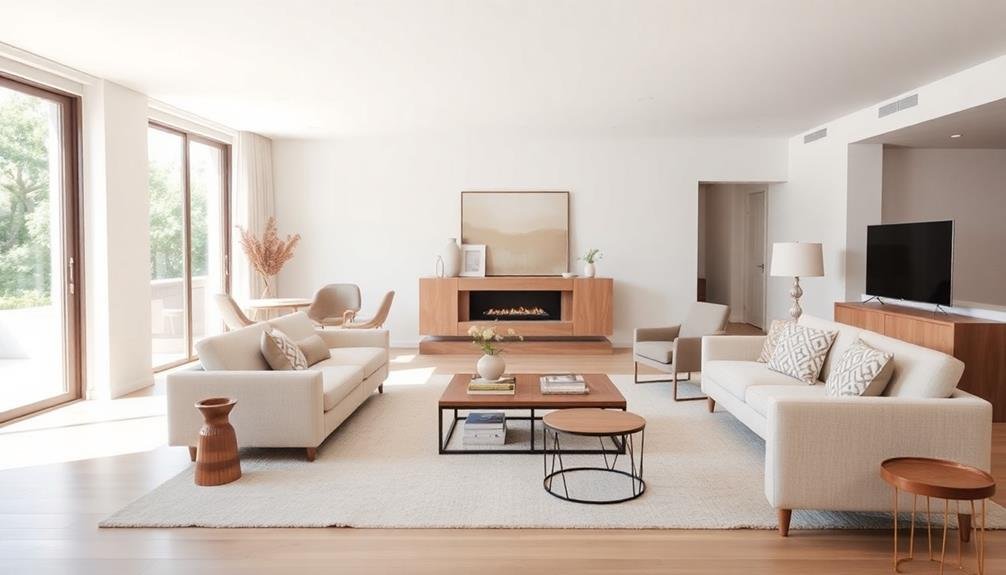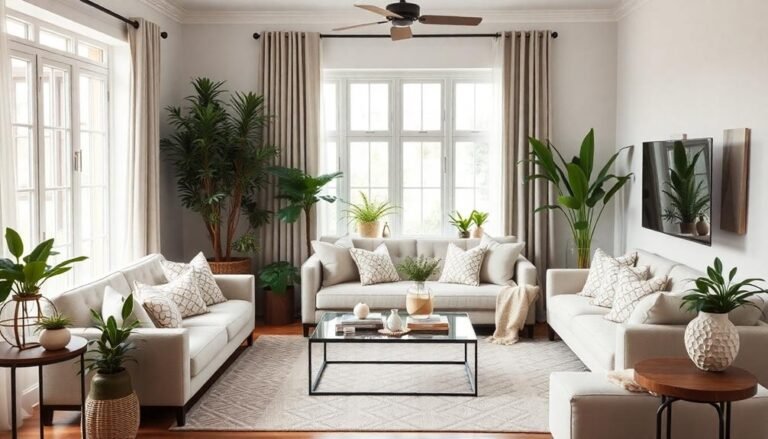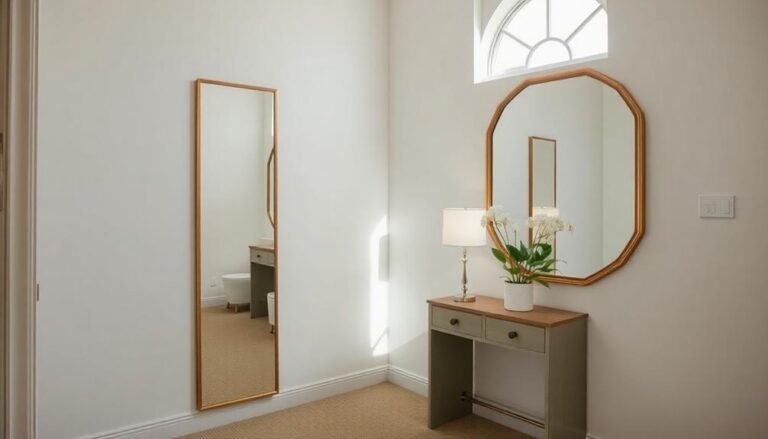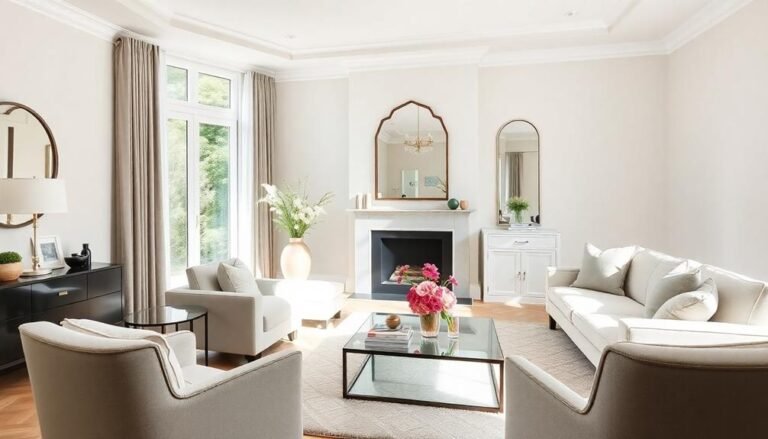To arrange your furniture for a spacious, buyer-friendly look, start by evaluating your space, including room dimensions and architectural features. Choose appropriately scaled, multifunctional furniture—like storage ottomans—while incorporating light colors to create an airy feel. Prioritize flow by positioning larger items first and maintaining clear pathways. Highlight key features, such as fireplaces or artwork, by arranging seating for ideal sightlines. Additionally, use soft, neutral colors and minimize heavy window treatments to enhance natural light. By focusing on these elements, you'll create an inviting atmosphere that draws in potential buyers, showcasing your home's unique charm. There's much more to explore beyond this.
Assess Your Space
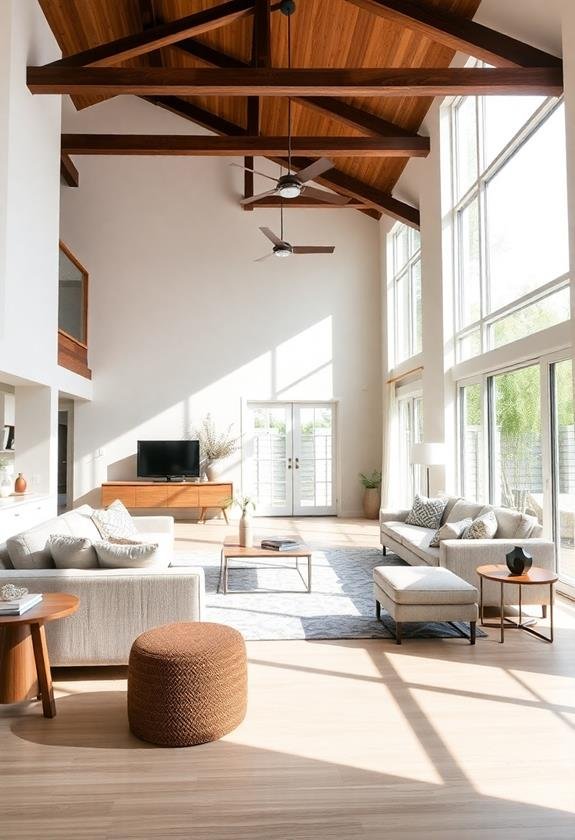
Before you immerse yourself in arranging your furniture, it's essential to assess your space. Start by measuring the dimensions of the room, including the height, width, and length. This gives you a clear understanding of your area's proportions, helping you visualize how different arrangements might look. Next, take note of architectural features, such as windows, doors, and any built-in elements that could affect your layout.
Consider the flow of movement within the space. You'll want to guarantee that pathways are clear and that people can move freely without obstruction. Imagine how you'd navigate the room during daily activities; this will help you prioritize functionality. Think about the focal points of the room too, whether it's a cozy fireplace or a stunning view outside. Position your furniture to enhance these features, drawing attention where it matters.
Choose the Right Furniture
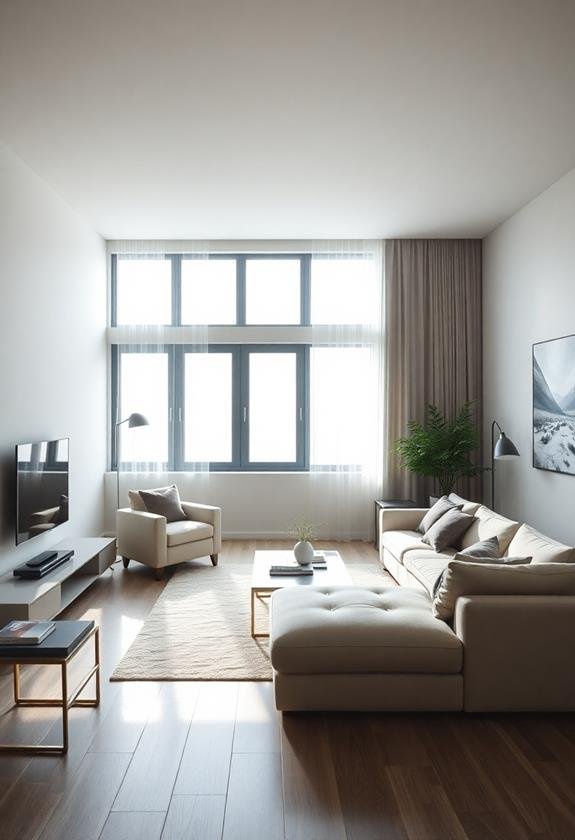
Selecting the right furniture can transform your space, making it feel more open and inviting. Start by considering the scale of your furniture; oversized pieces can overwhelm a room, while smaller, streamlined options can create an airy atmosphere. For instance, a sleek sofa with clean lines can open up your living room, whereas bulky armchairs may close it off. To enhance your design, consider incorporating stylish modern accent chairs that complement your existing decor and add visual interest to elevate your space.
Next, think about multifunctional furniture. Items like a coffee table with storage or a sofa bed can maximize utility without cluttering your space. This way, you maintain functionality while keeping the area looking spacious.
Color plays a vital role too. Light-colored furniture can reflect natural light, enhancing the feeling of openness. If you opt for darker pieces, balance them with lighter decor elements to avoid a heavy atmosphere.
Arrange for Flow
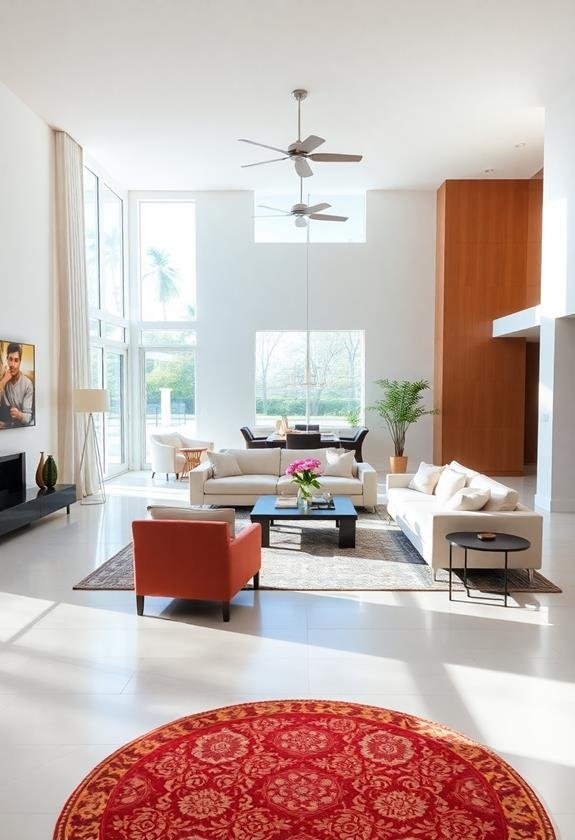
Creating a harmonious flow in your space is vital for both functionality and aesthetics. When arranging furniture, think about how people will move through the room. Start by positioning larger pieces, like sofas or beds, in a way that creates clear pathways. You want to avoid cluttered areas that make it hard to navigate. For example, if your living room has a coffee table, make sure there's enough space around it for easy movement—ideally, three feet of clearance is best. Incorporating multi-functional furniture can also help maximize your space while maintaining a clean look.
Next, consider the purpose of each area. If you have a designated reading nook, place a chair and lamp in a cozy corner, making certain it's accessible without blocking traffic flow. Also, think about the sightlines; arranging furniture to encourage eye contact fosters conversation and connection.
Lastly, balance is key. Distribute furniture evenly to prevent one side from feeling heavy or cramped. By creating zones that serve specific functions while allowing for easy passage between them, you'll establish a welcoming environment. This approach not only enhances the look of your home but also makes it feel more spacious and inviting, which is vital when potential buyers come to visit.
Highlight Key Features
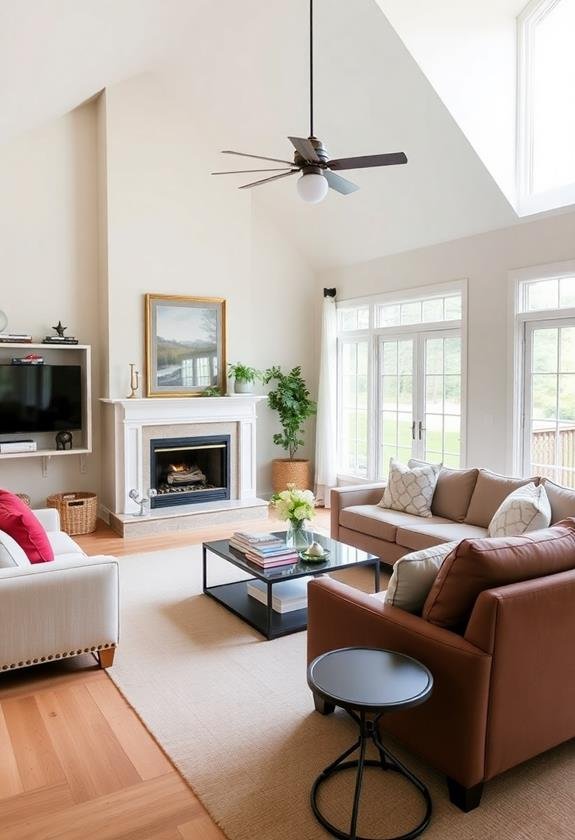
Once you've established a functional flow in your space, it's time to focus on highlighting key features that draw the eye and enhance the overall aesthetic. Consider the architectural elements of your home, like a stunning fireplace or beautiful bay windows. Arrange your furniture to emphasize these aspects; for example, position a cozy chair near the fireplace, inviting people to sit and enjoy its warmth. Adding elements like the Positive Little Reminders Desk Wood Plaque Sign can further enrich the inviting atmosphere while providing thoughtful messages throughout your space.
You can also use furniture placement to showcase artwork or decor. If you have a striking piece of art on the wall, make certain your seating faces it, allowing guests to appreciate it fully. Similarly, if your room has built-in shelving, leave ample space around it, so it doesn't feel cramped and is appreciated for its design.
Don't forget about the importance of balance. Distributing visual weight across the room can help draw attention to key features. For instance, if you have a large piece of furniture on one side, balance it with a tall plant or a slim bookshelf on the other. By thoughtfully arranging your space, you not only create a welcoming environment but also make it easier for potential buyers to see the unique charm your home offers.
Use Color and Light
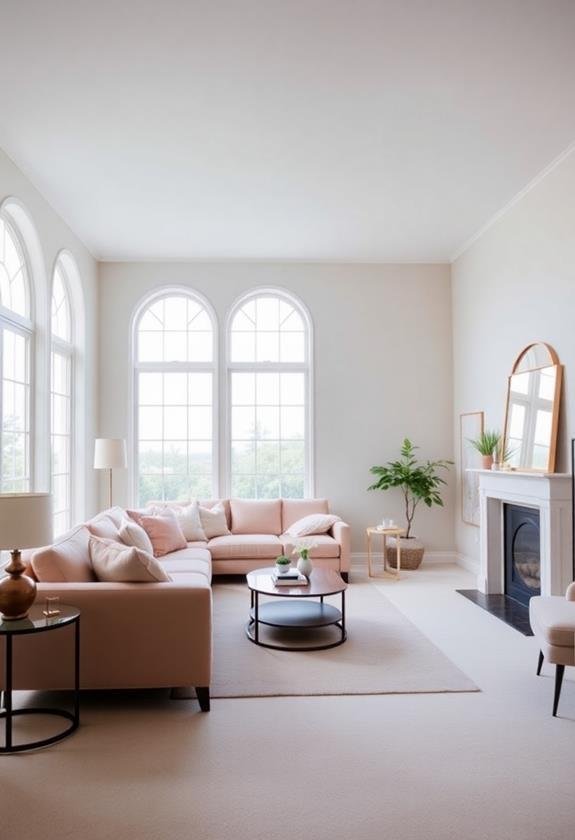
Color and light play essential roles in making a space feel more open and inviting. When you choose a color palette, consider soft, neutral tones like light grays, beiges, or whites, as these shades can reflect light and create a sense of spaciousness. Dark colors, while cozy, can make rooms appear smaller, so use them sparingly, perhaps as accent walls or in lesser-used areas.
Natural light is your best friend. Keep window treatments minimal to maximize sunlight, which brightens the room and enhances colors. If you're lacking natural light, strategically place mirrors across from windows to bounce light around and give the illusion of a larger space.
Additionally, you can use layered lighting—combining ambient, task, and accent lights—to create depth and warmth. For instance, a stylish floor lamp can provide cozy light for reading, while recessed lighting can offer an overall glow that keeps the space feeling airy.
Frequently Asked Questions
How Can I Measure My Space Accurately for Furniture Arrangement?
To measure your space accurately for furniture arrangement, start by grabbing a measuring tape. Measure the length and width of the room, noting any architectural features like windows or doors. Make a sketch of the layout, including these elements. You can also use an app for a digital approach. Don't forget to measure your furniture too, ensuring it'll fit comfortably in the space without crowding or obstructing pathways.
What Are Some Budget-Friendly Furniture Options for Staging?
When you're staging a space on a budget, consider using versatile pieces like slipcovered sofas or modular furniture that can adapt to different layouts. Thrift stores and online marketplaces often have hidden gems, like vintage chairs or tables, that add character without breaking the bank. You might also explore DIY options, such as painting old furniture or creating your own decor, to enhance the space while keeping costs low.
Should I Remove Personal Items When Staging My Home?
When staging your home, it's wise to remove personal items. Think of it like decluttering your closet before a big date; you want to present your best self. By clearing away family photos, memorabilia, and personal knickknacks, you create a neutral space that allows potential buyers to envision themselves living there. A clean, uncluttered environment feels more inviting, making it easier for buyers to imagine their future in your home.
How Can I Create a Focal Point in a Small Room?
To create a focal point in a small room, start by choosing a standout piece, like a bold artwork or a unique piece of furniture. Position this item where it draws the eye, such as above a fireplace or on a feature wall. Use lighting to highlight it, and arrange other furniture around it to enhance the effect. This way, you direct attention, making the room feel more inviting and purposeful.
What Are Common Mistakes to Avoid When Arranging Furniture?
Arranging furniture is like piecing together a jigsaw puzzle; every piece must fit just right. You'll want to avoid common mistakes, such as pushing all furniture against the walls, which can make a room feel cramped. Also, don't forget to create pathways for easy movement; a cluttered layout can be off-putting. Finally, guarantee your arrangement encourages conversation, making spaces feel inviting and functional for everyone. Keep these tips in mind for a better setup!

